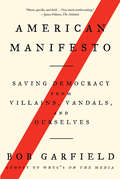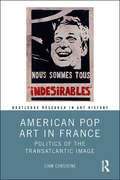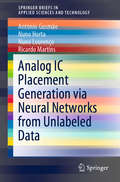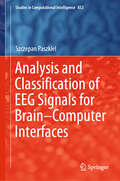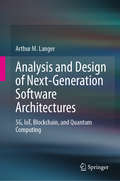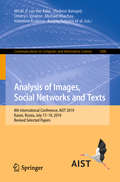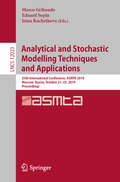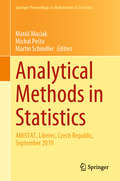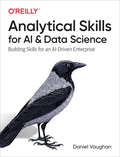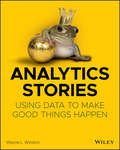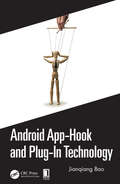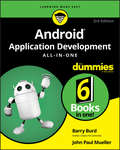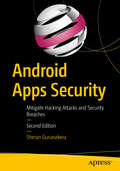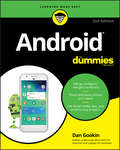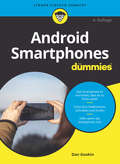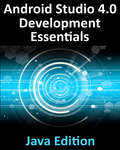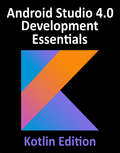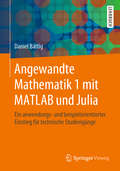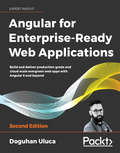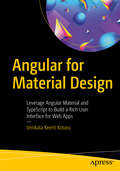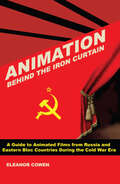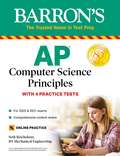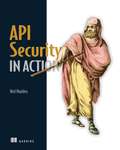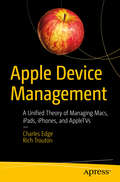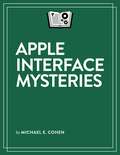- Table View
- List View
American Manifesto: Saving Democracy from Villains, Vandals, and Ourselves
by Bob GarfieldDo you fear for our democracy? Are you perplexed by Trumpism? Are you ready to throw in the towel? Don’t! This is your guidebook to reassembling our hyperpolarized American society in six (not–so–easy) steps, written by cohost of WNYC's On the Media Bob GarfieldAs is often observed, Trump is a symptom of a virus that has been incubating for at least fifty years. But not often observed is where the virus is imbedded: in the psychic core of our identity. In American Manifesto: Saving Democracy from Villains, Vandals, and Ourselves, popular media personality Bob Garfield examines the tragic confluence of the American preoccupation with identity and the catastrophic disintegration of the mass media. Garfield investigates how we’ve gotten to this moment when our identity is threatened by both the left and the right, when e pluribus unum is no longer a source of national pride, and why, when looking through this lens of identity, the rise of Trumpism is no surprise. Overlaying this crisis is the rise of the Facebook–Google duopoly and the filter bubble of social media, where identity is insular and immutable.But fear not! WNYC’s On the Media cohost Garfield has ideas about how we may counter the forces of fragmentation—the manifesto itself: six steps to take to reassemble our fractured society. A quick, fascinating read, American Manifesto offers not only a vision of a country in extremis, but also a plan for how to address the ways in which our democracy is imperiled. Provocative, profound, and sometimes hilariously profane, American Manifesto is a call to action like no other.
American Pop Art in France: Politics of the Transatlantic Image (Routledge Research in Art History)
by Liam ConsidinePop art was essential to the Americanization of global art in the 1960s, yet it engendered resistance and adaptation abroad in equal measure, especially in Paris. From the end of the Algerian War of Independence and the opening of Ileana Sonnabend’s gallery for American Pop art in Paris in 1962, to the silkscreen poster workshops of May ’68, this book examines critical adaptations of Pop motifs and pictorial devices across French painting, graphic design, cinema and protest aesthetics. Liam Considine argues that the transatlantic dispersion of Pop art gave rise to a new politics of the image that challenged Americanization and prefigured the critiques and contradictions of May ’68.
Analog IC Placement Generation via Neural Networks from Unlabeled Data (SpringerBriefs in Applied Sciences and Technology)
by António Gusmão Nuno Horta Nuno Lourenço Ricardo MartinsIn this book, innovative research using artificial neural networks (ANNs) is conducted to automate the placement task in analog integrated circuit layout design, by creating a generalized model that can generate valid layouts at push-button speed. Further, it exploits ANNs’ generalization and push-button speed prediction (once fully trained) capabilities, and details the optimal description of the input/output data relation. The description developed here is chiefly reflected in two of the system’s characteristics: the shape of the input data and the minimized loss function. In order to address the latter, abstract and segmented descriptions of both the input data and the objective behavior are developed, which allow the model to identify, in newer scenarios, sub-blocks which can be found in the input data. This approach yields device-level descriptions of the input topology that, for each device, focus on describing its relation to every other device in the topology. By means of these descriptions, an unfamiliar overall topology can be broken down into devices that are subject to the same constraints as a device in one of the training topologies. In the experimental results chapter, the trained ANNs are used to produce a variety of valid placement solutions even beyond the scope of the training/validation sets, demonstrating the model’s effectiveness in terms of identifying common components between newer topologies and reutilizing the acquired knowledge. Lastly, the methodology used can readily adapt to the given problem’s context (high label production cost), resulting in an efficient, inexpensive and fast model.
Analysis and Classification of EEG Signals for Brain–Computer Interfaces (Studies in Computational Intelligence #852)
by Szczepan PaszkielThis book addresses the problem of EEG signal analysis and the need to classify it for practical use in many sample implementations of brain–computer interfaces. In addition, it offers a wealth of information, ranging from the description of data acquisition methods in the field of human brain work, to the use of Moore–Penrose pseudo inversion to reconstruct the EEG signal and the LORETA method to locate sources of EEG signal generation for the needs of BCI technology. In turn, the book explores the use of neural networks for the classification of changes in the EEG signal based on facial expressions. Further topics touch on machine learning, deep learning, and neural networks. The book also includes dedicated implementation chapters on the use of brain–computer technology in the field of mobile robot control based on Python and the LabVIEW environment. In closing, it discusses the problem of the correlation between brain–computer technology and virtual reality technology.
Analysis and Design of Next-Generation Software Architectures: 5G, IoT, Blockchain, and Quantum Computing
by Arthur M. LangerThis book provides a detailed “how-to” guide, addressing aspects ranging from analysis and design to the implementation of applications, which need to be integrated within legacy applications and databases.The analysis and design of the next generation of software architectures must address the new requirements to accommodate the Internet of things (IoT), cybersecurity, blockchain networks, cloud, and quantum computer technologies. As 5G wireless increasingly establishes itself over the next few years, moving legacy applications into these new architectures will be critical for companies to compete in a consumer-driven and social media-based economy. Few organizations, however, understand the challenges and complexities of moving from a central database legacy architecture to a ledger and networked environment.The challenge is not limited to just designing new software applications. Indeed, the next generation needs to function more independently on various devices, and on more diverse and wireless-centric networks. Furthermore, databases must be broken down into linked list-based blockchain architectures, which will involve analytic decisions regarding which portions of data and metadata will be processed within the chain, and which ones will be dependent on cloud systems. Finally, the collection of all data throughout these vast networks will need to be aggregated and used for predictive analysis across a variety of competitive business applications in a secured environment. Certainly not an easy task for any analyst/designer!Many organizations will continue to use packaged products and open-source applications. These third-party products will need to be integrated into the new architecture paradigms and have seamless data aggregation capabilities, while maintaining the necessary cyber compliances. The book also clearly defines the roles and responsibilities of the stakeholders involved, including the IT departments, users, executive sponsors, and third-party vendors. The book’s structure also provides a step-by-step method to help ensure a higher rate of success in the context of re-engineering existing applications and databases, as well as selecting third-party products, conversion methods and cybercontrols. It was written for use by a broad audience, including IT developers, software engineers, application vendors, business line managers, and executives.
Analysis of Images, Social Networks and Texts: 8th International Conference, AIST 2019, Kazan, Russia, July 17–19, 2019, Revised Selected Papers (Communications in Computer and Information Science #1086)
by Vladimir Batagelj Panos M. Pardalos Andrey V. Savchenko Dmitry I. Ignatov Wil M. P. van der Aalst Marcello Pelillo Michael Khachay Natalia Loukachevitch Sergei O. Kuznetsov Irina A. Lomazova Amedeo Napoli Valentina Kuskova Andrey Kutuzov Elena TutubalinaThis book constitutes the proceedings of the 8th International Conference on Analysis of Images, Social Networks and Texts, AIST 2019, held in Kazan, Russia, in July 2019.The 24 full papers and 10 short papers were carefully reviewed and selected from 134 submissions (of which 21 papers were rejected without being reviewed). The papers are organized in topical sections on general topics of data analysis; natural language processing; social network analysis; analysis of images and video; optimization problems on graphs and network structures; analysis of dynamic behaviour through event data.
Analytical and Stochastic Modelling Techniques and Applications: 25th International Conference, ASMTA 2019, Moscow, Russia, October 21–25, 2019, Proceedings (Lecture Notes in Computer Science #12023)
by Marco Gribaudo Eduard Sopin Irina KochetkovaThis book constitutes the refereed proceedings of the 25th International Conference on Analytical and Stochastic Modelling Techniques and Applications, ASMTA 2019, held in Moscow, Russia, in October 2019. Methods of analytical and stochastic modelling are widely used in engineering to assess and design various complex systems, like computer and communication networks, and manufacturing systems. The 13 full papers presented in this book were carefully reviewed and selected from 22 submissions. The papers detail a diverse range of analysis techniques, including Markov processes, queueing theoretical results, reliability of stochastic systems, stochastic network calculus, and wide variety of applications.
Analytical Methods in Statistics: AMISTAT, Liberec, Czech Republic, September 2019 (Springer Proceedings in Mathematics & Statistics #329)
by Matúš Maciak Michal Pešta Martin SchindlerThis book collects peer-reviewed contributions on modern statistical methods and topics, stemming from the third workshop on Analytical Methods in Statistics, AMISTAT 2019, held in Liberec, Czech Republic, on September 16-19, 2019. Real-life problems demand statistical solutions, which in turn require new and profound mathematical methods. As such, the book is not only a collection of solved problems but also a source of new methods and their practical extensions. The authoritative contributions focus on analytical methods in statistics, asymptotics, estimation and Fisher information, robustness, stochastic models and inequalities, and other related fields; further, they address e.g. average autoregression quantiles, neural networks, weighted empirical minimum distance estimators, implied volatility surface estimation, the Grenander estimator, non-Gaussian component analysis, meta learning, and high-dimensional errors-in-variables models.
Analytical Skills for AI and Data Science: Building Skills for an AI-Driven Enterprise
by Daniel VaughanWhile several market-leading companies have successfully transformed their business models by following data- and AI-driven paths, the vast majority have yet to reap the benefits. How can your business and analytics units gain a competitive advantage by capturing the full potential of this predictive revolution? This practical guide presents a battle-tested end-to-end method to help you translate business decisions into tractable prescriptive solutions using data and AI as fundamental inputs.Author Daniel Vaughan shows data scientists, analytics practitioners, and others interested in using AI to transform their businesses not only how to ask the right questions but also how to generate value using modern AI technologies and decision-making principles. You’ll explore several use cases common to many enterprises, complete with examples you can apply when working to solve your own issues.Break business decisions into stages that can be tackled using different skills from the analytical toolboxIdentify and embrace uncertainty in decision making and protect against common human biasesCustomize optimal decisions to different customers using predictive and prescriptive methods and technologiesAsk business questions that create high value through AI- and data-driven technologies
Analytics Stories: Using Data to Make Good Things Happen
by Wayne L. WinstonInform your own analyses by seeing how one of the best data analysts in the world approaches analytics problems Analytics Stories: How to Make Good Things Happen is a thoughtful, incisive, and entertaining exploration of the application of analytics to real-world problems and situations. Covering fields as diverse as sports, finance, politics, healthcare, and business, Analytics Stories bridges the gap between the oft inscrutable world of data analytics and the concrete problems it solves. Distinguished professor and author Wayne L. Winston answers questions like: Was Liverpool over Barcelona the greatest upset in sports history? Was Derek Jeter a great infielder What's wrong with the NFL QB rating? How did Madoff keep his fund going? Does a mutual fund’s past performance predict future performance? What caused the Crash of 2008? Can we predict where crimes are likely to occur? Is the lot of the American worker improving? How can analytics save the US Republic? The birth of evidence-based medicine: How did James Lind know citrus fruits cured scurvy? How can I objectively compare hospitals? How can we predict heart attacks in real time? How does a retail store know if you're pregnant? How can I use A/B testing to improve sales from my website? How can analytics help me write a hit song? Perfect for anyone with the word “analyst” in their job title, Analytics Stories illuminates the process of applying analytic principles to practical problems and highlights the potential pitfalls that await careless analysts.
Android App-Hook and Plug-In Technology
by Jianqiang BaoThis book presents the Android plug-in technology used in Android development. This technology is widely used by a majority of Chinese internet companies, and is becoming more widely used worldwide. The book fully describes the history of Android plug-in technology, the installation and startup process, and new features of the Android plug-in technology. It also explores plug-in solutions for peripheral technologies. The book is designed to help Android app developers better understand the underlying technology of the Android system. Features Introduces Android system knowledge, including the communication between AMS and four components Describes the Hook technique by Proxy.newProxyInstance and reflection, to modify Android system behavior, for example, to launch an activity not declared in the AndroidManifest. Shows how to use the Hook apk packaging process in Gradle Covers how to merge the resources in the plugin app and the host app, and how to merge dex of the host app and all the plugin apps Presents the SO technique and how to launch SO files dynamically
Android Application Development All-in-One For Dummies
by Barry Burd John Paul MuellerAndroid Application Development For Dummies All-In-One, 3rd Edition gathers six Android For Dummies mini-books into one friendly guide. You’ll go from Android newbie all the way to confident programmer and learn to develop apps for the world’s largest smart phone market. Kotlin experts Barry Burd and John Paul Mueller introduce you to Android programming from start to finish! Like all For Dummies books, this guide is written with clear explanations and careful organization, so non-technical readers and experienced programmers alike can get up to speed quickly. This new edition covers the latest features and enhancements to the Android platform. Learn how to develop apps for all sorts of devices including: your smartphone, tablet, wearables, TV, auto, and Internet of Things (IoTs) like your refrigerator Discover the new Kotlin programming language, which makes development easier Create apps even faster than before using the new techniques found in this book Develop apps for the largest smartphone market to reach the biggest possible audience This book focuses on Android 10, the newest and most flexible Android platform. Get started turning your app development dreams into reality today!
Android Apps Security: Mitigate Hacking Attacks and Security Breaches (Apressus Ser.)
by Sheran GunasekeraGain the information you need to design secure, useful, high-performing apps that expose end-users to as little risk as possible. This book shows you how to best design and develop Android apps with security in mind: explore concepts that you can use to secure apps and how you can use and incorporate these security features into your apps.What You Will LearnIdentify data that should be securedUse the Android APIs to ensure confidentiality and integrity of dataBuild secure apps for the enterpriseImplement Public Key Infrastructure and encryption APIs in appsMaster owners, access control lists, and permissions to allow user control over app propertiesManage authentication, transport layer encryption, and server-side securityWho This Book Is ForExperienced Android app developers.
Android For Dummies
by Dan GookinSet up, configure, and get connected Shoot and share photos and videos Use social media, text, and email to stay in touch Make the most of your Android gizmo Be honest—isn't "gizmo" a friendlier word than "device"? This book will tell you pretty much everything you need to know about your Android smartphone or tablet in an equally friendly manner, because that's the best way to learn how to get the most from your Android. From buying, unpacking, and setting up your gizmo to managing calls and email, posting to social media, navigating with Maps, and creating a photo slideshow, it's like having a good friend show you the basics and explain how to take advantage of all the cool stuff. Inside... All about Android 10 Updated security features Customizing your Android Creating multimedia messages Apps to help you get social The Bluetooth connection Exploring Google Play Essential troubleshooting tips
Android Smartphones für Dummies (Für Dummies)
by Dan GookinEgal welches Android-Smartphone Sie Ihr eigen nennen - ob von Samsung, LG, Sony oder HTC, um nur einige Hersteller zu nennen - und egal mit welcher Android-Version das Smartphone läuft, in diesem Buch erfahren Sie, wie Sie alles aus Ihrem Gerät herausholen können. Richten Sie Ihr Smartphone gemäß Ihren Bedürfnissen ein, surfen Sie im Internet, lesen Sie Ihre Mails, nutzen Sie soziale Netzwerke wie Facebook, Instagram und Twitter, laden Sie Apps und Musik auf Ihr Smartphone, finden Sie alle wichtigen Funktionen und noch ein paar mehr. Dieses Buch führt Sie in die verborgenen Tiefen Ihres Smartphones. Es geht auf die Funktionen ein, über die jedes Android-Smartphone verfügt, auf Besonderheiten einzelner Geräte und auf die Funktionen neuer Versionen. Wenn Sie mehr Smartphone-Tricks beherrschen wollen, aber nicht so viel Zeit investieren können, dann ist dieses Buch genau das richtige für Sie.
Android Studio 4.0 Development Essentials - Java Edition: Build Android apps with Android Studio 4.0 and Java
by Neil SmythExplore Android Studio 4.0 and update your skills to build modern applications in Java Key Features Set up your Android development and testing environments Create user interfaces with Android Studio Editor, XML, and Java Explore the essential elements of Android Jetpack Book Description Android rolls out frequent updates to meet the demands of the dynamic mobile market and to enable its developer community to lead advancements in application development. This book focuses on the updated features of Android Studio (the fully integrated development environment launched by Google) to build reliable Android applications using Java. The book starts by outlining the steps necessary to set up an Android development and testing environment. You'll then learn how to create user interfaces with the help of Android Studio Layout Editor, XML files, and by writing the code in Java. The book introduces you to Android architecture components and advanced topics such as intents, touchscreen handling, gesture recognition, multi-window support integration, and biometric authentication, and lets you explore key features of Android Studio 4.0, including the layout editor, direct reply notifications, and dynamic delivery. You'll also cover Android Jetpack in detail and create a sample app project using the ViewModel component. Finally, you'll upload your app to the Google Play Console and handle the build process with Gradle. By the end of this book, you'll have gained the skills necessary to develop applications using Android Studio 4.0 and Java. What you will learn Design impressive UI for Android application using Android Studio Editor and Java Understand how Android Jetpack can help you reduce the amount of code Explore unique ways to handle single-touch and multi-touch events Trigger local and remote notifications on the device Integrate biometric authentication into an Android app Create, test, and upload an Android app bundle on Google Play Store Who this book is for This book is for application developers and Java programmers who want to explore Android Studio 4.0 to create powerful Android applications. A basic understanding of Java and the Android SDK will be helpful.
Android Studio 4.0 Development Essentials - Kotlin Edition: Build Android Apps with Android Studio 4.0 and Kotlin
by Neil SmythUpgrade your Android Studio skills and confidently create, test, and upload Android applications using KotlinKey FeaturesDiscover how to set up Android development and testing environmentsPractice object-oriented programming (OOP) in KotlinExplore all the major elements of Android JetpackBook DescriptionKotlin as an Android-compatible programming language is becoming increasingly popular. Fully updated for Android Studio 4.0, this book will teach you the skills necessary to develop Android-based applications using Kotlin.Starting with the basics, this book outlines the steps necessary to set up Android development and testing environments, and goes on to introduce you to programming in Kotlin. You'll practice Java to Kotlin code conversion and explore data types, operators, expressions, loops, functions, as well as the basics of OOP in Kotlin. You'll then learn about Android architecture components and advanced topics, such as intents, touchscreen handling, gesture recognition, multi-window support integration, and biometric authentication. As you make progress, you'll explore Android Studio 4.0's key features, including layout editor, direct reply notifications, and dynamic delivery. You'll also delve into Android Jetpack and create a sample app project using ViewModel, the Android Jetpack component. Finally, you will upload your app to Google Play Console and model the build process using Gradle.By the end of this Android book, you'll be fully prepared to develop applications using Android Studio 4.0 and Kotlin.What you will learnBuild Android apps by writing less error-prone code using KotlinReduce the amount of code using Android JetpackExplore unique ways of handling single and multi-touch eventsTrigger local and remote notifications on the deviceIntegrate biometric authentication into an Android appCreate, test, and upload an Android app bundle on Google Play StoreWho this book is forIf you are an application developer or programmer who wants to learn how to build reliable Android applications using Kotlin and Android Studio 4.0, then this book is for you. A basic understanding of programming languages and Android SDK is necessary.
Angewandte Mathematik 1 mit MATLAB und Julia: Ein anwendungs- und beispielorientierter Einstieg für technische Studiengänge
by Daniel BättigDieses Lehrbuch vermittelt die Grundlagen der höheren Mathematik für ingenieurwissenschaftliche und andere MINT-Studiengänge. Im Vordergrund stehen dabei Analysis, Differenzialrechnung und lineare Algebra als klassische Themen des ersten Semesters. Diese werden anhand von Beispielen und Anwendungen aus Technik, Physik und Chemie vermittelt. Zudem werden systematisch die Programmiersprachen MATLAB und Julia verwendet, um Modelle zu implementieren und mathematische Probleme zu lösen. Zahlreiche Übungsaufgaben runden jedes Kapitel ab, Lösungen dazu sind online verfügbar. Für Lehrende sind darüber hinaus auch Präsentationsfolien zum Buch über die Verlagsseite abrufbar. Das Buch richtet sich an Studierende, die ein Bachelorstudium in angewandten Wissenschaften an einer Hochschule beginnen. Studierenden an technischen Universitäten kann das Buch dank der vielen Beispiele helfen, einführende Kurse in Analysis und linearer Algebra besser zu verstehen. Verschiedene Kapitel zu Zahlensystemen, Vektoren, Funktionen und zur Differenzialrechnung können auch für Kurse an Gymnasien benutzt werden.
Angular for Enterprise-Ready Web Applications: Build and deliver production-grade and cloud-scale evergreen web apps with Angular 9 and beyond, 2nd Edition
by Doguhan UlucaRevised and updated second edition of the bestselling hands-on guide to building enterprise-ready web apps using an evergreen Angular platform Key Features Updated examples, projects, and a new overview of tools – including NgRX and Ivy, automated testing, and Firebase authentication New chapter summarizing history of web frameworks and Angular version updates All-new RESTful API implementation leveraging the MEAN stack with MongoDB, Express.js, Angular and Node.js Book Description This second edition of Angular for Enterprise-Ready Web Applications is updated with in-depth coverage of the evergreen Angular platform. You'll start by mastering Angular programming fundamentals. Using the Kanban method and GitHub tools, you'll build great-looking apps with Angular Material and also leverage reactive programming patterns with RxJS, discover the flux pattern with NgRx, become familiar with automated testing, utilize continuous integration using CircleCI, and deploy your app to the cloud using Vercel Now and GCloud. You will then learn how to design and develop line-of-business apps using router-first architecture with observable data anchors, demonstrated through oft-used recipes like master/detail views, and data tables with pagination and forms. Next, you'll discover robust authentication and authorization design demonstrated via integration with Firebase, API documentation using Swagger, and API implementation using the MEAN stack. Finally, you will learn about DevOps using Docker, build a highly available cloud infrastructure on AWS, capture user behavior with Google Analytics, and perform load testing. By the end of the book, you'll be familiar with the entire gamut of modern web development and full-stack architecture, learning patterns and practices to be successful as an individual developer on the web or as a team in the enterprise. What you will learn Adopt a minimalist, value-first approach to delivering web apps Master Angular development fundamentals, RxJS, CLI tools, GitHub, and Docker Discover the flux pattern and NgRx Implement a RESTful APIs using Node.js, Express.js, and MongoDB Create secure and efficient web apps for any cloud provider or your own servers Deploy your app on highly available cloud infrastructure using DevOps, CircleCI, and AWS Who this book is for This book is for developers who want to confidently deliver high-quality and production-grade Angular apps from design to deployment. Developers that have prior experience in writing a RESTful APIs will also benefit, as well as developers who will gain greater awareness of how they fit into the larger picture of delivering a web application. Prior experience with RESTful APIs is desired.
Angular for Material Design: Leverage Angular Material and TypeScript to Build a Rich User Interface for Web Apps
by Venkata Keerti KotaruBuild Angular applications faster and better with TypeScript and Material Design. You will learn how to build a web interface and use Google's open source Angular Material library of ready-made and easy-to-use components.This book uses Angular with TypeScript (a superset to JavaScript) to enable use of data types and take advantage of programming constructs such as classes, interfaces, generic templates, and more. You also will utilize various Angular features, including data binding, components, services, etc. You will build a single page application with the help of routing capabilities available out of the box (Angular CLI) and interface with remote services over HTTP.What You Will LearnBuild an application using Angular, TypeScript, and Angular MaterialUnderstand Angular concepts such as components, directives, services, and moreUse TypeScript features, including data types, classes, interfaces, generic templates, etc.Build a single page application (SPA) with routing features and integrate it with server-side remote servicesWho This Book Is ForBeginning to intermediate level professionals will learn about web development using Angular, TypeScript, and Angular Material. Patterns and practices are recommended to be a successful developer. Basic knowledge of JavaScript is helpful.
Animation Behind the Iron Curtain
by Eleanor CowenAnimation Behind the Iron Curtain is a journey of discovery into the world of Soviet era animation from Eastern Bloc countries. From Jerzy Kucia's brutally exquisite Reflections in Poland to the sci-fi adventure of Ott in Space by Estonian puppet master Elbert Tuganov to the endearing Gopo's little man by Ion Popescu-Gopo in Romania, this excursion into Soviet era animation brings to light magnificent art, ruminations on the human condition, and celebrations of innocence and joy.As art reveals the spirit of the times, animation art of Eastern Europe during the Cold War, funded by the Soviet states, allowed artists to create works illuminating to their experiences, hopes, and fears. The political ideology of the time ironically supported these artists while simultaneously suppressing more direct critiques of Soviet life. Politics shaped the world of these artists who then fashioned their realities into amazing works of animation. Their art is integral to the circumstances in which they lived, which is why this book combines the unlikely combination of world politics and animated cartoons.The phenomenal animated films shared in this book offer a glimpse into the culture and hearts of Soviet citizens who grew up with characters as familiar and beloved to them as Mickey Mouse and Bugs Bunny are to Americans. This book lays out the basic political dynamics of the Cold War and how those political tensions affected the animation industry in both the US and in the Eastern Bloc. And, for animation novices and enthusiasts alike, Animation Behind the Iron Curtain also offers breakout sections to explain many of the techniques and aesthetic considerations that go into this fascinating art form. This book is a must read for anyone interested in the Cold War era and really cool animated films!
AP Computer Science Principles: With 4 Practice Tests (Barron's Test Prep)
by Seth ReichelsonBarron&’s brand new AP Computer Science Principles is designed to help students prepare for exam topics, regardless of what computer language or method they learned. This book is aligned with the AP Computer Science course, which was first introduced in the 2017-2018 academic year.This edition includes:Three practice exams in the book, with an additional exam available onlineIn-depth instructions on how to complete the Explore Performance Tasks and the Create Performance Tasks.Sample responses that earn high scores and sample responses that earn low scoresThe questions and examples all reflect the style of recent exam questions and cover the essential knowledge topics outlined by College Board.
API Security in Action
by Neil MaddenAPI Security in Action teaches you how to create secure APIs for any situation. By following this hands-on guide you&’ll build a social network API while mastering techniques for flexible multi-user security, cloud key management, and lightweight cryptography.Summary A web API is an efficient way to communicate with an application or service. However, this convenience opens your systems to new security risks. API Security in Action gives you the skills to build strong, safe APIs you can confidently expose to the world. Inside, you&’ll learn to construct secure and scalable REST APIs, deliver machine-to-machine interaction in a microservices architecture, and provide protection in resource-constrained IoT (Internet of Things) environments. Purchase of the print book includes a free eBook in PDF, Kindle, and ePub formats from Manning Publications. About the technology APIs control data sharing in every service, server, data store, and web client. Modern data-centric designs—including microservices and cloud-native applications—demand a comprehensive, multi-layered approach to security for both private and public-facing APIs. About the book API Security in Action teaches you how to create secure APIs for any situation. By following this hands-on guide you&’ll build a social network API while mastering techniques for flexible multi-user security, cloud key management, and lightweight cryptography. When you&’re done, you&’ll be able to create APIs that stand up to complex threat models and hostile environments. What's inside Authentication Authorization Audit logging Rate limiting Encryption About the reader For developers with experience building RESTful APIs. Examples are in Java. About the author Neil Madden has in-depth knowledge of applied cryptography, application security, and current API security technologies. He holds a Ph.D. in Computer Science. Table of Contents PART 1 - FOUNDATIONS 1 What is API security? 2 Secure API development 3 Securing the Natter API PART 2 - TOKEN-BASED AUTHENTICATION 4 Session cookie authentication 5 Modern token-based authentication 6 Self-contained tokens and JWTs PART 3 - AUTHORIZATION 7 OAuth2 and OpenID Connect 8 Identity-based access control 9 Capability-based security and macaroons PART 4 - MICROSERVICE APIs IN KUBERNETES 10 Microservice APIs in Kubernetes 11 Securing service-to-service APIs PART 5 - APIs FOR THE INTERNET OF THINGS 12 Securing IoT communications 13 Securing IoT APIs
Apple Device Management: A Unified Theory of Managing Macs, iPads, iPhones, and AppleTVs
by Charles Edge Rich TroutonWorking effectively with Apple platforms at a corporate or business level includes not only infrastructure, but a mode of thinking that administrators have to adopt to find success. A mode of thinking that forces you to leave 30 years of IT dogma at the door. This book is a guide through how to integrate Apple products in your environment with a minimum of friction. Because the Apple ecosystem is not going away.You'll start by understanding where Apple, third-party software vendors, and the IT community is taking us. What is Mobile Device Management and how does it work under the hood. By understanding how MDM works, you will understand what needs to happen on your networks in order to allow for MDM, as well as the best way to give the least amount of access to the servers or services that’s necessary. You'll then look at management agents that do not include MDM, as well as when you will need to use an agent as opposed to when to use other options. Once you can install a management solution, you can deploy profiles on a device or you can deploy profiles on Macs using scripts. With Apple Device Management as your guide, you'll customize and package software for deployment and lock down devices so they’re completely secure. You’ll also work on getting standard QA environments built out, so you can test more effectively with less effort. Apple is forging their own path in IT. They trade spots with Amazon, Google, and Microsoft as the wealthiest company to ever exist. And they will not be constrained by 30 or more years of dogma in the IT industry. You can try to shoehorn Apple devices into outdated modes of device management, or you can embrace Apple’s stance on management with the help of this book.What You'll LearnDeploy profiles across devices effectively and securelyInstall apps remotely both from the app store and through custom solutionsWork natively with Apple environments rather than retrofitting older IT solutionsWho This Book Is ForMac administrators within organizations that want to integrate with the current Apple ecosystem, including Windows administrators learning how to use/manage Macs, mobile administrators working with iPhones and iPads, and mobile developers tasked with creating custom apps for internal, corporate distribution.
Apple Interface Mysteries
by Michael E. CohenApple devices are supposed to be easy to use, and they generally are—at least for basic things. But over the years, as features have multiplied exponentially and hardware has changed dramatically, the user interfaces of Macs, iPhones, and iPads (among other Apple products) have become increasingly inscrutable. This book explores the mysteries of how and why things are the way they are now—and shows you how you can solve your own Apple usability puzzles.
